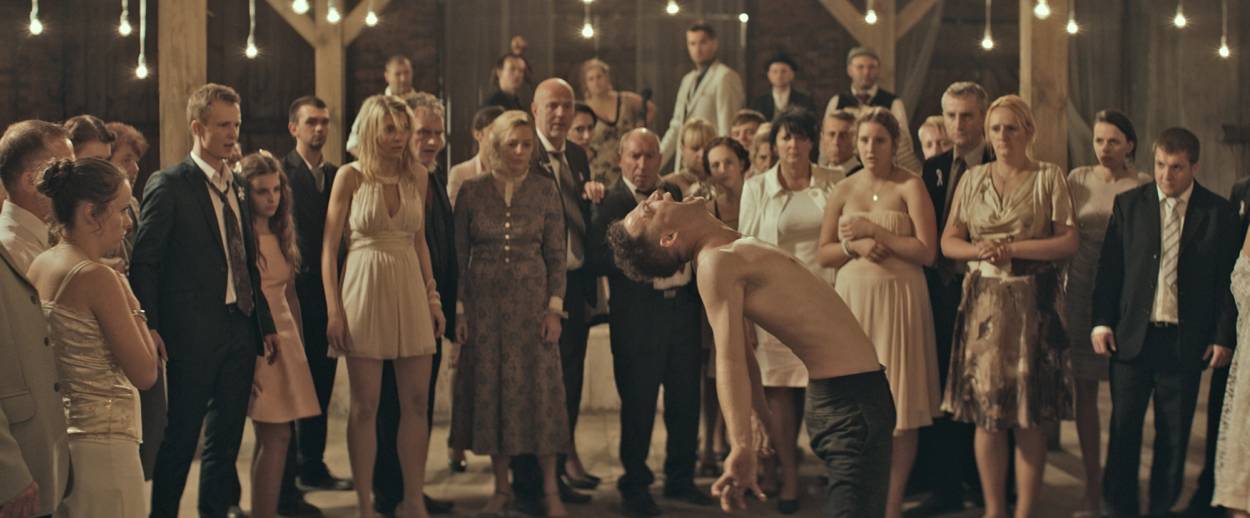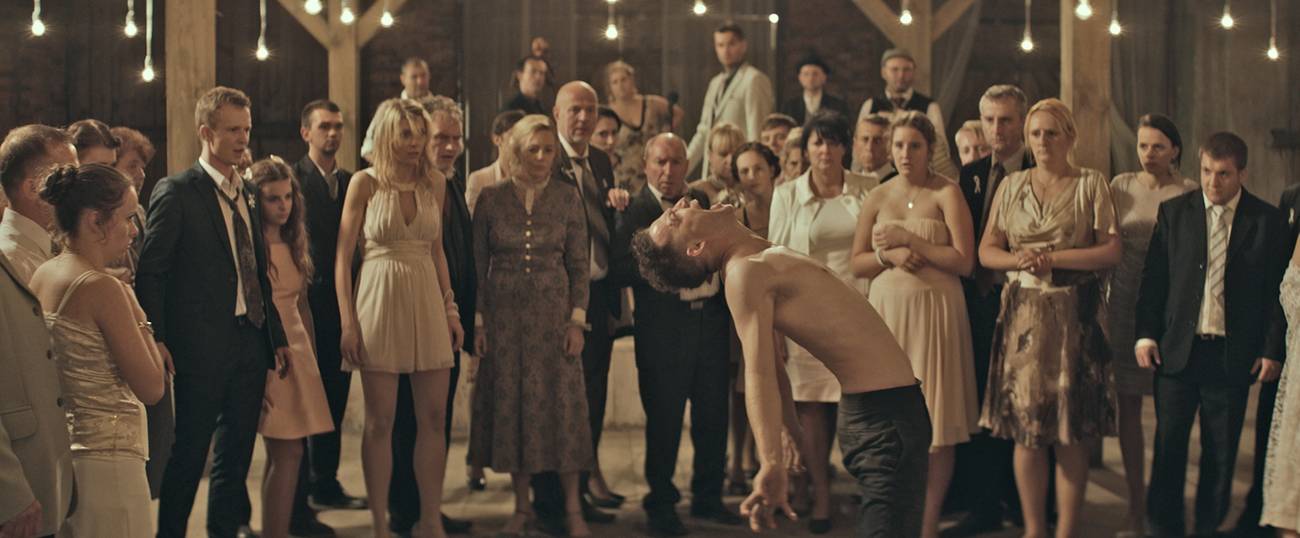A Polish Director and His Country Possessed By Jewish Demons
The late Marcin Wrona’s dark new Dybbuk parable digs deep into a haunted past




S. Anski’s verse play The Dybbuk is arguably the key Jewish artwork of the past century as well as the unexpected inspiration for an audacious new Polish film, Demon, co-written and directed by the late Marcin Wrona. The drama of a Jewish bride who is possessed by a dybbuk—the spirit of her dead lover—on the eve of her marriage to a man chosen by her father, embodies the conflict between modernity and tradition. It also evokes a world in which the living mingle with the dead and the past asserts its hold on the present.
Written in Russian during World War I, The Dybbuk was informed both by Anski’s pre-WWI ethnographic explorations in the so-called dark continent that was Jewish Pale of Settlement and his firsthand witness of Galicia’s wartime destruction. The play was translated into Hebrew, and because the Russian version was lost, from Hebrew into Yiddish, which is how it was first performed in Warsaw by the Vilna Troupe, shortly after Anski’s death, in 1920. A year later, another new art theater, the Hebrew-language Habima, gave The Dybbuk had its premiere in Moscow. Thereafter the play would be synonymous with both Israel’s future state theater Habima and the Yiddish stage; filmed in Poland in 1937, The Dybbuk was also the basis for the most celebrated of Yiddish talkies.

Over the decades, The Dybbuk has been performed all over the world, translated into scores of languages; it was adapted for several ballets, turned into an opera, and broadcast in English on American TV with Carol Lawrence, the original star of West Side Story, in the role of the possessed bride. It has also inspired numerous plays and movies—none more freighted with historical baggage than Demon. Evidently possessed by his own demons, the director committed suicide, age 42, shortly after the film’s premiere at the 2015 Gdynia Film Festival. The director, whose two earlier features, My Flesh, My Blood (2009) and The Christening (2010), are dark parables on fate and mortality, haunts his own film. So does Polish history.
Demon, which opens in New York on Sept. 9, is one of three recent fiction films that might be said to literalize the return of Poland’s repressed with plots that pivot on unearthing evidence of Polish Jews murdered on Polish soil during WWII. The first and most sensational of these, Wladyslaw Pasikowski’s Aftermath (2012), is a kind of genre film—part-thriller, part-“guilty town” Western—in which a Polish émigré to America returns home to his village to find the natives attempting to suppress the fact that it was they, rather than the Nazis, who massacred their Jewish neighbors.
More artful and restrained, Pawel Pawlikowski’s Oscar-winning Ida (2013, reviewed here in Tablet magazine) is a period piece, set in 1962, concerning a young orphan raised by Catholic nuns. As she prepares to take her vows, she discovers that she was born of Jewish parents who perished in the Holocaust. A key scene, echoing one in Aftermath, reveals the appropriation of a Jewish house. Another involves the excavation of a mass grave outside a once-Jewish village.
Demon, Wrona’s third and last feature, a Polish-Israeli co-production, is a supernatural film, as well as a family of melodrama and extremely dark comedy. Python, an outsider whose origins are unclear (but who is played by Israeli actor Itay Tiran) comes to Poland to marry a local woman, Zaneta (Agnieszka Zulewska), whom he met while both were living in Britain. The wedding is held in a picturesque if rundown manor acquired by the bride’s overbearing father, Zygmunt (Andrzej Grabowski), a high-powered contractor and obvious beneficiary of Poland’s post-Communist economy.
The afternoon of Python’s arrival, which requires the portentous crossing of a river, he is spooked by the sight of what he imagines are human remains, glimpsed in an excavation on his prospective in-laws’ property. The discovery, which no one else sees, triggers a nightmare. In the midst of the prolonged and riotous wedding that consumes much of the movie’s running time, Python is possessed by the spirit of Hana, a local Jewish girl who was killed during the war, perhaps on her own wedding day.
Initially somewhat stilted, the film’s action grows increasingly wild as Wrona choreographs the marriage of Python and Zaneta. The atmosphere may be somber—the colors are muted and some scenes appear monochromatic—but the mood is manic as well as foreboding. A hard rain begins falling during the wedding and, although the terrain around the manor is reduced to the consistency of a primal swamp, the drunk and frenzied celebrants are hardly deterred.
The bad spirit at his own wedding, Python keeps insisting that there is a skeleton buried outside. His behavior grows increasingly bizarre—we alone see that he keeps imagining a dark young lady who at one point briefly whirls him in a mazurka that is comparable to the danse macabre in the 1937 Dybbuk. Python’s mad fit is initially attributed to vodka, then epilepsy, and finally some obscure, possibly inherited, mental weakness.
***
Demon is more a Polish than a Jewish story. The land where Python finds himself is variously visualized as a massive construction site, in which things seem more likely to be buried than excavated, and a mysterious ruin wherein revelers reenact intricate folk rituals. Although inspired by Anski, Demon was freely based on Piotr Rowicki’s 2008 play Adherence, in which a Polish criminal gang takes over a small town only to have their leader possessed by the spirit of a young Jewish woman murdered there during the war. Demon also draws on another classic, Andrzej Wajda’s tumultuous 1971 adaptation of Stanisław Wyspiański’s turn-of-the-20th-century dramatic allegory, The Wedding. Here the wedding of a poet and a peasant woman is used to celebrate and critique the Polish nationalism that fueled the doomed anti-Russian uprisings of 1830 and 1863.
As The Wedding is populated by symbolically resonant figures, so too is Demon. While the spirited bride is innocent of history, her parents are characterized by accommodation and denial. A cynical, alcoholic doctor seems to open himself to mysticism during the course of events while an ineffectual, somewhat cowardly priest appears to lose a measure of his faith.
The least convincing but most crucial of the supporting wedding guests is a professor and self-described “old Jew” (Wlodzimierz Press) who is available to question the dybbuk when Python begins ranting in Yiddish—a language no one else recognizes, let alone understands. Most of what the professor says, even in Polish, is similarly unintelligible. None of the other guests seem to grasp the implication of his explanation that, even if he knew how, he could not perform an exorcism without a minyan. Nevertheless, the rumor spreads: “They say a Jewish demon possessed the groom!” If it is fear of excommunication from the community of Jews that drives out Anski’s dybbuk, here there is no longer a Jewish community from which the spirit might be cast out.
Anski’s play is the ur-text for a tendency in Jewish art and literature that the Yiddishist Jeffrey Shandler has called “haunted modernism.” Literary examples include Franz Kafka, Bruno Schultz, and Isaac Bashevis Singer; the best-known painters are Marc Chagall and Natan Altman who, at least in their early work, were possessed by an uncanny past. Even before the Holocaust, the displacement and violent destruction of an ancient collective past prompted many writers, artists, and performers to view the vanished or vanishing traditional communities in which they originated as essentially ghostly—and to therefore reimagine these rural towns and urban ghettos as fantastic landscapes or haunted graveyards. Published a year before The Dybbuk was first performed, Sigmund Freud’s essay “The Uncanny” similarly anticipates the ambivalent engagement with the Jewish past by positing the uncanny as the return of something that “ought to have remained hidden.” This Jewish intimation of a past that, however lost, will not remain buried has also been experienced by some non-Jewish Central European artists. The Polish dramatist Tadeusz Kantor, best known for his 1975 theater piece The Dead Class, was one. Wrona, who was born in Tarnow—a once half-Jewish town in southeast Poland—and was by some accounts the child of a professional exorcist, was another.
The wedding craziness is matched by Python’s. He jerks around like Beetlejuice during his convulsive fits, then dissolves into timorous, maidenly tears, still babbling in Yiddish, as an EMS crew administers a sedative. Meanwhile, the bride suffers her own mania, at one point digging with her hands for corpses in the yard, and the old professor is more quietly possessed by his past, recalling the child Hana and her sisters, comforting the dybbuk by singing a bit of the Yiddish lullaby Almonds and Raisins. In fact, everyone at the wedding is possessed. Come the dawn, the father of the bride dismisses the night’s revelry as a “mass hallucination” and, in a magnificent double-negative filled with historical significance, declares that “we must forget what we didn’t see.” Here, Marcin inserts a close-up in which the glass that was stepped on during the wedding ceremony magically reconstitutes itself. Soon, the bride’s father will unconsciously lapse into Russian, the language of Poland’s most consistent conqueror, and the bride will—well, you’ll have to see for yourself.
***
To read more of J. Hoberman’s National Magazine Award-nominated film criticism for Tablet magazine, click here.
J. Hoberman was the longtime Village Voice film critic. He is the author, co-author, or editor of 12 books, including Bridge of Light: Yiddish Film Between Two Worlds and, with Jeffrey Shandler, Entertaining America: Jews, Movies, and Broadcasting.